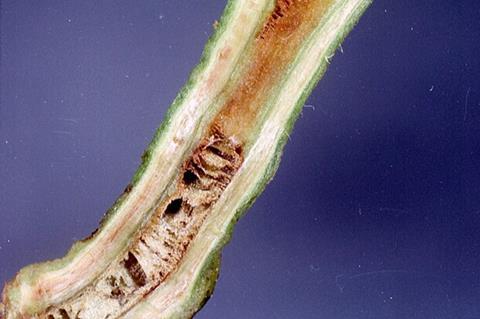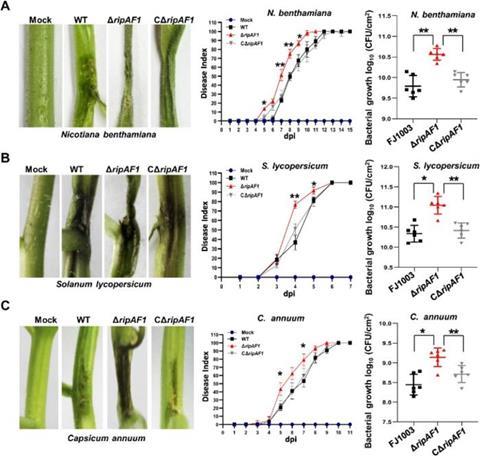A recent study has uncovered how the pathogen Ralstonia solanacearum disrupts plant defenses through its type III effector RipAF1. The research shows that RipAF1 modifies a critical plant protein, FBN1, via ADP-ribosylation, which alters the plant’s hormonal signaling balance, suppressing jasmonic acid (JA) and enhancing salicylic acid (SA) pathways.

This mechanism allows the pathogen to facilitate disease progression, offering new insights into plant-pathogen interactions that could pave the way for innovative disease management strategies in agriculture.
READ MORE: Calcium can protect potato plants from bacterial wilt
READ MORE: Beneficial bacteria lured by siren call of plant hormones
Bacterial wilt caused by Ralstonia solanacearum poses a severe threat to agriculture worldwide, affecting numerous crops. The pathogen’s arsenal of type III effectors (T3Es) enables it to manipulate host defense mechanisms, aiding infection. One major challenge in managing bacterial wilt is understanding how these effectors interact with plant signaling pathways. This complexity underscores the need for detailed studies on effectors like RipAF1 to devise targeted strategies for effective disease management.
Plant immune responses
In a study (DOI: 10.1093/hr/uhae162) published in Horticulture Research on June 12, 2024, scientists from Hainan University and Fujian Agriculture and Forestry University, among other Chinese institutions, explored the function of RipAF1, a type III effector from Ralstonia solanacearum.
The research demonstrates how RipAF1 modulates plant immune responses by ADP-ribosylating the fibrillin protein FBN1, leading to the suppression of asmonic acid (JA) signaling and the activation of salicylic acid (SA) signaling. These findings provide crucial insights into RipAF1’s role in reshaping plant hormone pathways.

The study reveals that RipAF1 plays a critical role in manipulating plant defenses by targeting FBN1 through ADP-ribosylation. Experiments showed that removing RipAF1 from the pathogen increased its virulence in plants like Nicotiana benthamiana, Solanum lycopersicum, and Capsicum annuum.
RipAF1’s ADP-ribosylation activity is essential for modulating the crosstalk between JA and SA pathways, highlighting specific conserved residues in FBN1 crucial for this effect. The discovery underscores RipAF1’s unique ability to fine-tune plant defense mechanisms, suggesting new opportunities to control bacterial wilt through effector-targeted approaches.
Key breakthrough
“RipAF1’s ability to manipulate plant hormone signaling represents a key breakthrough in understanding effector function,” said Dr. Huasong Zou from Huzhou College. “The effector’s ADP-ribosylation of host proteins reconfigures defense responses, showcasing the sophisticated tactics employed by Ralstonia solanacearum. This insight opens the door to developing effector-based strategies that could significantly reduce the impact of bacterial wilt on crops.” Dr. Zou highlighted that targeting these processes could revolutionize disease management in agriculture.
Identifying RipAF1’s role in modulating plant defense signaling has significant implications for agricultural disease control. By targeting the effector’s ADP-ribosylation activity, new methods can be developed to enhance plant resistance against Ralstonia solanacearum. Insights into effector-host interactions also offer a pathway to engineering crops with improved immune responses, potentially decreasing dependence on chemical treatments. These findings emphasize the importance of exploring effector biology to create sustainable and effective approaches to managing bacterial wilt and similar diseases.







No comments yet